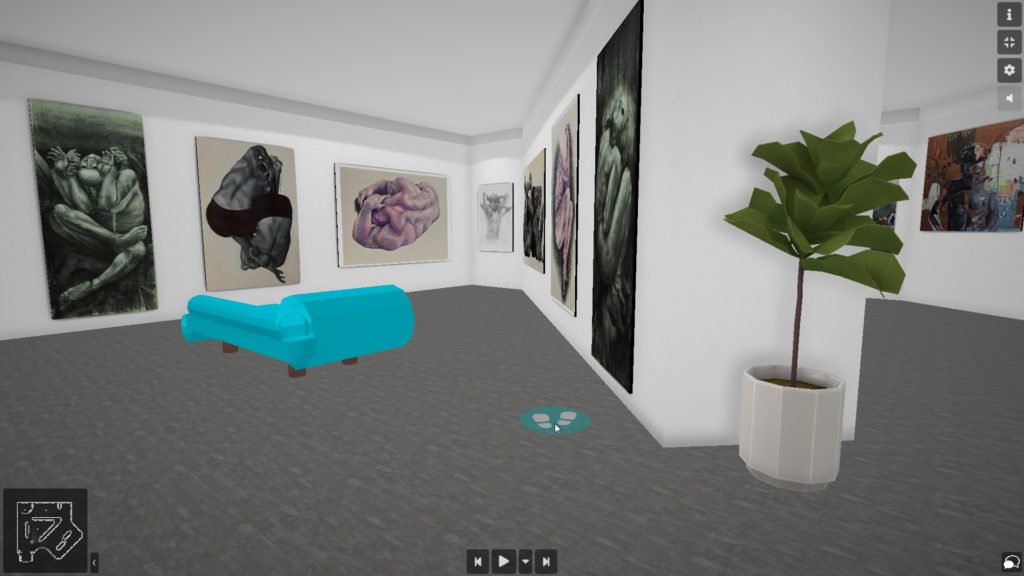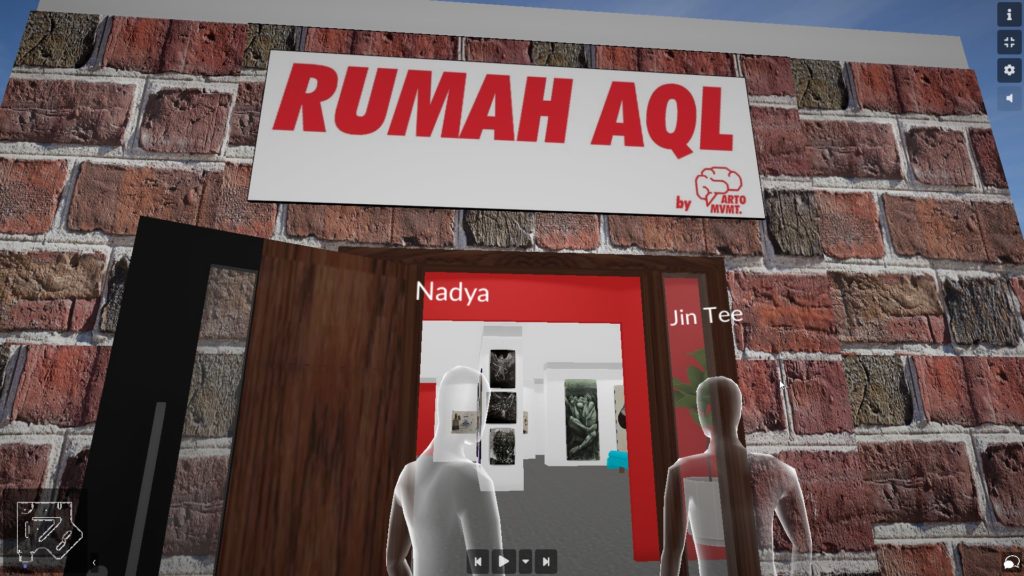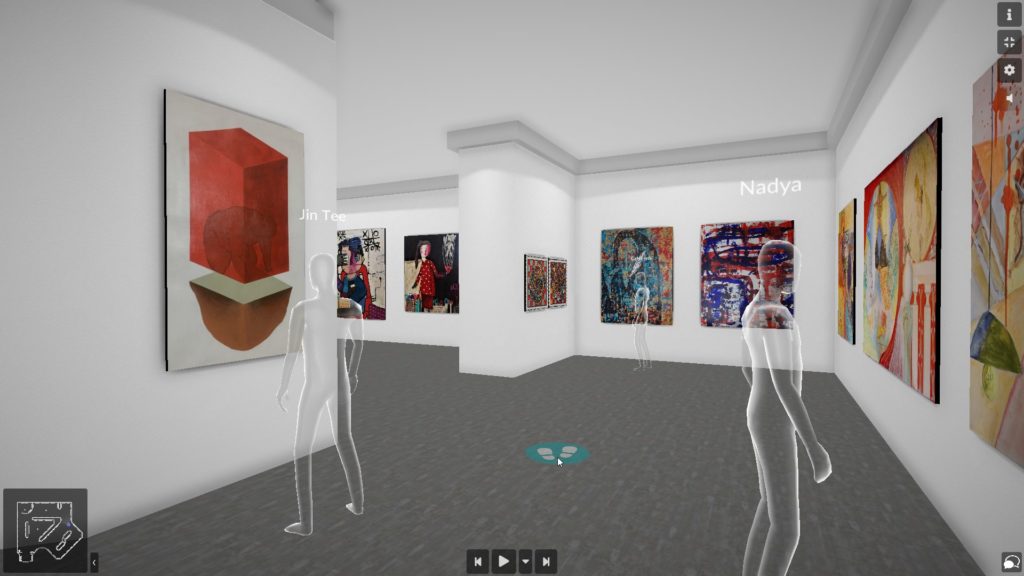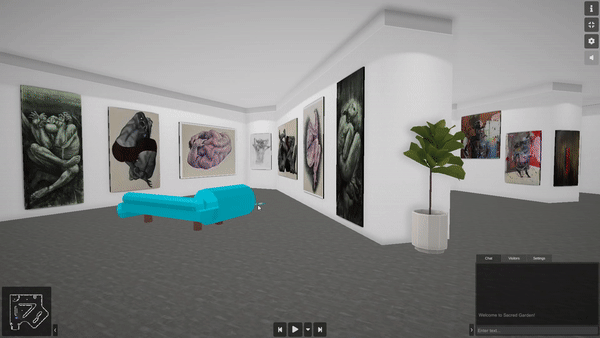
If you’re looking for something to do at home, online art exhibitions on Artsteps are surreal, compelling, and only a little bit frustrating.
By LIM JACK KIN
I went to an art gallery with my friends this week. No masks, no social distancing, no inter-district roadblocks. Also, no skin, flesh or bones; we were all phantom outlines, passing through each other as we sauntered from room to room. If that sounds more like a spooky-fever dream than a gallery experience, you wouldn’t be too far off. I am, of course, talking about Artsteps, the virtual art exhibition software we were using.
Beginning in the mid-90s as flat images to be scrolled through on a webpage, virtual galleries have come a long way. Some of the most impressive exhibits (Ilham Gallery’s The Body Politic and the Body, for example) function similarly to Google Street View: presented with a number of stitched-together panorama shots of the gallery, you look around and ‘move’ between predetermined points. And then there are platforms like Artsteps and Kunstmatrix. They’re different. These tools build a virtual 3D space from scratch, which you can walk inside as in a video game, even joining other visitors. The implications are fascinating, but what’s the experience actually like? I registered an Artsteps account, gathered a few reluctant friends, and together we visited a Malaysian exhibition, ARTO Movement’s Sacred Garden, to find out.
Artsteps is a simple platform; it runs in browsers, on mobile phones, and apparently has VR support. You use the WASD keys to walk, but have to click and drag the mouse to look around. It’s a small and somewhat annoying feature of the software, but something we got used to quickly. With the mouse, you can click on the ground to automatically walk to that location, or click on a work of art to get a straight-ahead view of it.
Movement is serviceable but clunky, and a minimap in the corner keeps you from getting lost. It’s reminiscent of the adventure video games of the early-2000s, but less technically polished. Visually, the platform works well enough when looking at the imported art, but anything textured like embroidery or thick paints shows up flat, losing all nuance. Away from the art, the 3D model textures are jagged and disjointed. I get the impression that there’s a selection of ready-made 3D objects available to gallery-creators; low-polygon benches and plants to insert into your space to provide ‘atmosphere’. Unfortunately, it had the opposite effect, only serving to remind you that you weren’t in a real art gallery. There was an option to set ‘graphics fidelity’ to high, but that just applied a motion-blur effect that looked like I smeared Vaseline over my glasses.

Low-quality 3D objects and environments feel jarring, juxtaposed with high-resolution art images.

“High Quality” really just means “bad post-processing”.
Another feature that Artsteps purports is the ability to view an exhibit with other people. This was the feature I was most excited about. Having roped in a few reluctant friends, we were all set to walk the Sacred Garden exhibit together.
In practice, though, things were a little disappointing. We had to refresh our browsers several times before our avatars synced up and became visible, and by the end, one of our group members was still unable to see us, though we could see her, wandering aimlessly. The chatbox was entirely non-functional. Half the time, the other avatars I saw stuttered awkwardly from place to place, rather than walked. The avatars themselves were white transparent outlines; they kept us from blocking the art but made the environment feel more purgatorial than pally.

Gallery visits, even virtual ones, are better with friends. Sort of.
Still, there were brief moments where everything worked just right. I’d turn a corner and see my girlfriend admiring a drawing I had just passed, or I’d come across my friends in the same room, all engrossed in different pieces. If you pair the experience with a voice-chat app or a Zoom call to communicate with each other, it’s remarkably fun despite the overall jankiness of movement or the feeling that we were all spirits in some grey afterlife.
The exhibit itself tied well into the experience; curated from an open call for submissions, Sacred Garden features 83 different works centered on figurative art from 50 different artists, including “fresh graduates” and “hobbyists”, according to its curator, the ARTO Movement collective. Each piece is beautiful and engaging on an individual level, ranging in medium from mixed-media collage to acrylic on canvas. Thematically, you can find meditations on mental health, feminist critiques, pop culture references, anything from the personal to the political. Though Artsteps struggles with rendering the more textured works—anything with embroidery or thick paint, for example—it lends itself well to viewing such a diverse collection.
It’s ARTO Movement’s curation that unfortunately lets down the exhibit; framing Sacred Garden as a “religiously-inspired” collection, the guided tour they offer is rather shallow. Lines like “If we crossed check all the (main) religion of the world i.e. Islam, Christianity, Buddhism, Hinduism, have made it clear that the body is something that is sacred and we have to take care of it wholeheartedly” feels overly reductive, both of world religion and the work displayed. While it bills itself as “a celebration of the human figure”, it’s not particularly diverse. Many of the figures took on visibly able-bodied, young, muscular, conventionally ‘beautiful’ forms. At least one piece suffered from a disturbing, sexualising ‘male gaze’: a man’s depiction of a woman breastfeeding her child, completely nude and in red lipstick. The curation could have benefited from a more focused and subtle hand, overall. Trying to fit all this work into a ‘sacredness’ narrative results in a disconnect between the art and its justification.

A group of friends in silent contemplation.

Multi-visitor functionality simply… didn’t work as well as we hoped.

Luqman AlHakim Abd Rahman’s Opocot!, a tribute to Stanley Kubrick
Overall, the Artsteps platform is a bizarre mishmash of functions that almost work, and therein lies the frustration. A flaw here, a glitch there, and they all add up into an experience that feels like it could have been so much more. But here’s the thing: I’m still using it. Perhaps it’s the strength of the art, but these tools are still wonderfully immersive. Hours after my friends have said goodbye and logged off, I still find myself loading up older shows long past their launch, looking at obscure exhibits with less than 20 total views, and exploring the “Latest” tab to find student shows and hobbyist work.
It will be decades before this technology can come close to replicating the tactility of an in-person visit to a gallery, or indeed the feeling of social wholeness you get when you go look at beautiful art with people you love. That said, there are undeniable perks to having easily-accessed, permanently-online records of an artist’s work for a fraction of the cost of physical representation. The curating world is now infinitely more accessible, expanding the number of curated experiences available to us at home. And for obsessives like me, there’s a host of new exhibits to wander through, wondering all the while if we’ll bump into another ghostly figure in an empty room.
For a collection of online exhibits, The Art Sceni has compiled a list available here.
Lim Jack Kin is a participant of the CENDANA – ASWARA Arts Writing Mentorship Programme 2020-2021.
